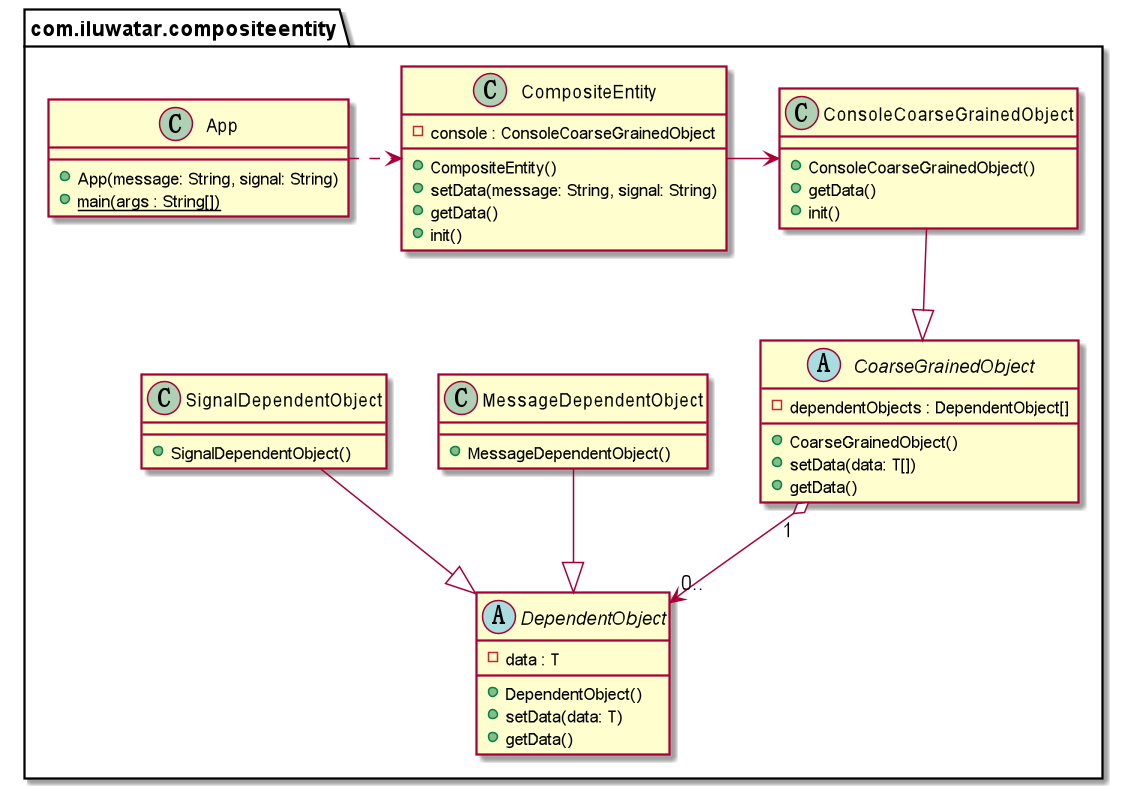* add composite entity pattern * add composite entity pattern * Update ReactorTest.java * resolve some code quality problems * modified a lot * remove some extra codes * modified README * removed the author name and adjusted the spacing Co-authored-by: zwebrain <11811721@mail.sustech.edu.cn> Co-authored-by: Subhrodip Mohanta <hello@subho.xyz>
layout, title, folder, permalink, categories, tags
| layout | title | folder | permalink | categories | tags | |
|---|---|---|---|---|---|---|
| pattern | Composite Entity | composite-entity | /patterns/composite-entity/ | Structural |
|
Intent
It is used to model, represent, and manage a set of persistent objects that are interrelated, rather than representing them as individual fine-grained entities.
Explanation
Real world example
For a console, there may be many interfaces that need to be managed and controlled. Using the composite entity pattern, dependent objects such as messages and signals can be combined together and controlled using a single object.
In plain words
Composite entity pattern allows a set of related objects to be represented and managed by a unified object.
Programmatic Example
We need a generic solution for the problem. To achieve this, let's introduce a generic Composite Entity Pattern.
public abstract class DependentObject<T> {
T data;
public void setData(T message) {
this.data = message;
}
public T getData() {
return data;
}
}
public abstract class CoarseGrainedObject<T> {
DependentObject<T>[] dependentObjects;
public void setData(T... data) {
IntStream.range(0, data.length).forEach(i -> dependentObjects[i].setData(data[i]));
}
public T[] getData() {
return (T[]) Arrays.stream(dependentObjects).map(DependentObject::getData).toArray();
}
}
The specialized composite entity console inherit from this base class as follows.
public class MessageDependentObject extends DependentObject<String> {
}
public class SignalDependentObject extends DependentObject<String> {
}
public class ConsoleCoarseGrainedObject extends CoarseGrainedObject<String> {
@Override
public String[] getData() {
super.getData();
return new String[]{
dependentObjects[0].getData(), dependentObjects[1].getData()
};
}
public void init() {
dependentObjects = new DependentObject[]{
new MessageDependentObject(), new SignalDependentObject()};
}
}
public class CompositeEntity {
private final ConsoleCoarseGrainedObject console = new ConsoleCoarseGrainedObject();
public void setData(String message, String signal) {
console.setData(message, signal);
}
public String[] getData() {
return console.getData();
}
}
Now managing the assignment of message and signal objects with the composite entity console.
var console = new CompositeEntity();
console.init();
console.setData("No Danger", "Green Light");
Arrays.stream(console.getData()).forEach(LOGGER::info);
console.setData("Danger", "Red Light");
Arrays.stream(console.getData()).forEach(LOGGER::info);
Class diagram
Applicability
Use the Composite Entity Pattern in the following situation:
- You want to manage multiple dependency objects through one object to adjust the degree of granularity between objects. At the same time, the lifetime of dependency objects depends on a coarse-grained object.
